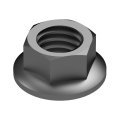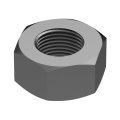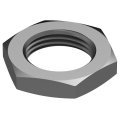Hex Nuts
The Essential Role of Hex Nuts in Industrial Fastening
Hex nuts are fundamental, general-purpose fasteners that are screwed on to the end of bolts to complete a connection. Their standard style features six sides and internal threading, but there are a wide variety of styles that stem from the standard to accommodate the equally wide range of mating fasteners and application needs. The differences in hex nuts are often in the height, thread type, finishes, and additional features like flanges, grooves, seals, and locking capabilities.
Huyett offers a selection of hex nuts in standard, flanged, wheel, panel, and self-sealing styles. Flanged nuts feature a built-in washer and eliminate the need for that extra fastener. The hex wheel style have a tall body with a tapered end that countersinks into lug holes. Panel nuts are thin and work well in low-profile applications, while self-sealing nuts have a seal protecting the ends of the threads. There are many other types of nuts, but their function is different enough to warrant their own category outside of “hex nuts.” For example, lock nuts refer to a specific yet large category of six-sided fasteners that feature nylon inserts, distorted threads, shorter bodies, serrated edges, and wedge designs that fortify their locking mechanism in unique ways. Huyett’s hex nuts exhibit standard locking capabilities but have characteristics that accommodate external application requirements.
- Durable Construction: Huyett offers these fasteners in multiple grades of steel with finishing options like zinc, waxed zinc, zinc clear, cadmium, and others to offer maximum strength and corrosion resistance.
- Ease of Installation: Simple design allows for quick and efficient assembly.
- Variety: Choose from a range of different sizes and styles to meet specific project requirements.
- Related Products: Shop Huyett’s selection of hex bolts, heavy hex nuts, structural heavy hex bolts, and more.
The Difference Between Hex Nuts and Jam Nuts
Hex nuts are the standard six-sided nuts that can be used on their own when a locking mechanism isn't required. In contrast, jam nuts are thinner and often used in tandem with a standard nut to wedge up against them and lock them into place. They do not facilitate the connection; they are there to fortify the hex nut’s locking capabilities.




